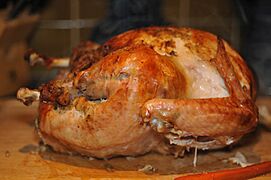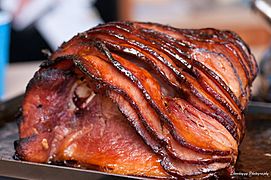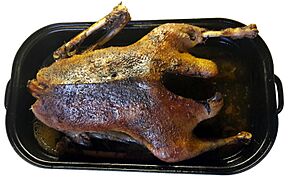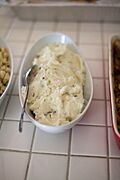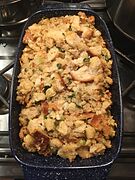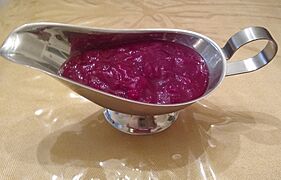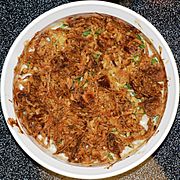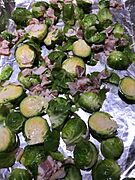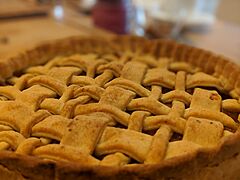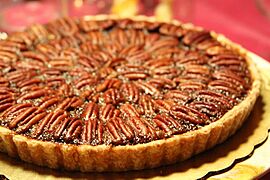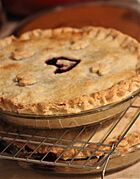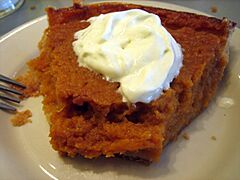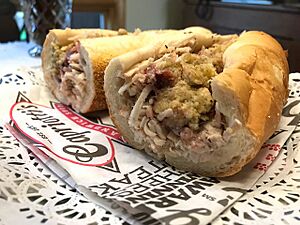Thanksgiving dinner facts for kids
Quick facts for kids Thanksgiving meal |
|
|---|---|
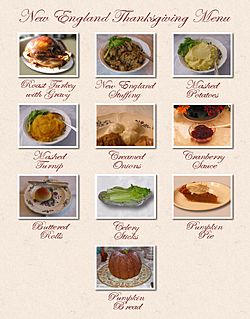
A Thanksgiving meal in New England
|
|
| Also called | Turkey dinner |
| Type | Cultural, Western |
| Date | Lua error in Module:Wikidata at line 132: attempt to index field 'wikibase' (a nil value). |
| Frequency | Annual |
Thanksgiving dinner is a big, special meal. It's the main part of the Thanksgiving holiday in the United States. People often call it "turkey dinner" because a large roasted turkey is usually the star! Thanksgiving is one of the biggest eating events in the U.S. People buy a lot of food and drinks for it. Many people eat a lot, sometimes thousands of calories, during this meal.
Thanksgiving dinner has always been a key part of the holiday, along with going to church services. In 2015, a survey found that Thanksgiving was the second most popular holiday in the U.S., right after Christmas. Turkey was also the most popular holiday food for everyone. At Thanksgiving dinner, turkey comes with many side dishes. Some are traditional, like mashed potatoes and cranberry sauce. Others might show off a family's special heritage.
Since Thanksgiving is about giving thanks, many families say a prayer before the meal. Many traditional Thanksgiving foods come from plants and animals native to the Americas. These include turkey, potatoes, sweet potatoes, corn, squash (like pumpkin), green beans, and cranberryes. The early Pilgrims might have learned about some of these from Native Americans. However, some foods weren't available to the first settlers. Eating these foods at Thanksgiving later on likely became popular because they were easy to get. The idea of huge feasts in the 1600s was mostly created by writers in the 1800s. They wanted to make Thanksgiving a holiday for all Americans to share.
Contents
The First Thanksgiving Meal
The idea of Thanksgiving dinner is often linked to New England. Early settlers there, called Puritans, would have special "days of thanksgiving." These days were for religious events, prayer, and sometimes fasting. Church records from that time don't often mention big meals or feasting. One record from 1636 mentions "making merry" after church, where richer people invited poorer ones to eat.
In 1621, Governor Edward Winslow of the Plymouth Colony wrote a letter. He described a three-day feast shared by the Plymouth settlers and the local Wampanoag tribe. Winslow sent four men to hunt for birds, enough to feed the colony for a week. Massasoit's hunters also killed five deer. In the 1800s, people started to connect this event with the idea of a Thanksgiving feast. In 1841, a writer named Alexander Young called it "the first thanksgiving, the harvest festival of New England." Other places, like Jamestown, Virginia, have also claimed to be the site of the "First Thanksgiving."
A writer named Sarah Josepha Hale worked hard to make Thanksgiving a national holiday. She wrote about it in her magazine, Godey's Lady's Book, starting in 1837. But she didn't link the Pilgrims to Thanksgiving until 1865. In a hymn she wrote in 1872, she said the Pilgrims were "free to do and pray, And keep in sober gladness Their first Thanksgiving Day." She didn't say their Thanksgiving included a big feast.
Other writers were less careful with facts. Jane G. Austin wrote a story about the Pilgrims in 1889 called Standish of Standish. She described the Pilgrims, a year after they arrived, having a huge feast. It included turkey stuffed with nuts, other birds, deer meat, boiled beef, oysters, clam chowder, and many desserts. Austin's story didn't match history, as many Pilgrims had died from hunger that winter. Still, her book was very popular. It was used in plays and schools. These writings helped create the popular, but not fully accurate, image of the Pilgrim Thanksgiving feast we know today.
Old Thanksgiving Menus
People in the United States were eating turkey for Thanksgiving even before Abraham Lincoln made it a national holiday in 1863. In her 1827 book Northwood; or, a Tale of New England, Sarah Josepha Hale wrote a whole chapter about Thanksgiving dinner. She mentioned many foods that are still traditional today. She said "the roasted turkey took precedence on this occasion," meaning it was the most important dish. For dessert, she said pumpkin pie was "an indispensable part of a good and true Yankee Thanksgiving."
The White House Cook Book, published in 1887, had a fancy Thanksgiving menu. It included oysters, chicken soup, fried smelts, roast turkey, cranberry sauce, mashed potatoes, baked squash, boiled onions, parsnip fritters, olives, chicken salad, venison pastry, pumpkin pie, mince pie, and many other desserts and fruits.
In 1935, soldiers in the Civilian Conservation Corps had a big Thanksgiving dinner. Their menu included pickles, olives, celery, roast turkey, oyster stew, cranberry sauce, giblet gravy, dressing, creamed asparagus, potatoes, baked carrots, hot rolls, fruit salad, mince pie, fruitcake, candies, grapes, and apples. They also had coffee.
During World War II, sugar and other foods were rationed from 1942 to 1946. In 1947, the Truman government tried to get Americans to eat less poultry (like chicken and turkey) on Thursdays. This was part of a plan to save food. Since Thanksgiving is always on a Thursday, this meant turkey and pumpkin pie (which uses eggs) were discouraged. Turkey farmers were upset! They talked to the President, and he agreed to stop discouraging turkey. But "Eggless Thursdays" continued for a while, so no pumpkin pie was served at the White House that year.
Main Dishes for Thanksgiving
Turkey
Turkey is the most common main dish for Thanksgiving dinner. It's so popular that the holiday is sometimes called "Turkey Day." Alexander Hamilton once said that "no citizen of the United States should refrain from turkey on Thanksgiving Day." Benjamin Franklin also thought highly of the wild turkey as an American symbol. As Thanksgiving became more popular in the 1800s, so did eating turkey. By 1857, turkey was a traditional part of the dinner in New England.
The domestic turkey we eat today is different from the wild turkey known to the Pilgrims. Wild turkeys are native to the Americas. They have lived here for about 5 million years. Today, you can find different types of wild turkeys in many states, Mexico, and Canada. The turkeys we eat today mostly come from a type of turkey taken from Mexico to Europe in the 1500s. Their descendants were later brought back to America.
In the 1900s, farmers bred turkeys to be bigger and have more white meat. The Beltsville Small White turkey was popular for about 20 years, starting in 1947. It was a smaller turkey, weighing 8-15 pounds. Then came the Broad Breasted White turkey. These turkeys were bred to be very large, sometimes over 40 pounds! They are so big that they need help to have babies. They also have health problems because of their size. Today, almost all turkeys eaten in America are Broad Breasted Whites. In 2006, American farmers raised 270 million turkeys. About one-third of all turkey eaten each year is during the Thanksgiving and Christmas holidays.
Thanksgiving turkey is often stuffed with a savory bread mix and then roasted. Sage is a common herb added to the stuffing, along with chopped onions and celery. Other things like nuts, sausage, bacon, carrots, cranberries, or apples can also be added. If the stuffing is cooked outside the bird, a broth is usually added to keep it from drying out. People in different regions might call it "stuffing" or "dressing." Some people also deep-fry their turkeys because it's faster, but this can be risky.
Eating turkey on Thanksgiving is such a strong tradition. Since 1947, the National Turkey Federation gives a live turkey to the president of the United States before Thanksgiving. At first, these turkeys were eaten for dinner. But since 1989, the president usually gives the turkey a special "pardon." This means the turkey gets to live out its life in a park. The first turkey "pardon" was given by President Abraham Lincoln in 1863.
- Main dishes for Thanksgiving dinner
Other Main Dishes
Sometimes, people serve other main dishes for Thanksgiving dinner. These can be served with the turkey or instead of it. Baked ham is popular in many homes. Roasted goose or duck are also sometimes served. These birds were traditionally eaten for Christmas dinner in Europe. Italian Americans might serve capon, which is a type of chicken. Irish Americans might have prime rib. In Ireland, beef was rare, so this dish showed new wealth.
Some families use birds native to their area. For example, a magazine called Texas Monthly once suggested quail as a main dish. On the West Coast of the United States, Dungeness crab is common because crab season starts in November. In the Northeastern United States, Thanksgiving is during deer hunting season, so venison (deer meat) is sometimes served. In some Alaskan villages, whale meat is eaten.
John Madden, a famous football commentator, loved turducken. This dish is a deboned turkey, duck, and chicken, all stuffed inside each other and then cooked!
For vegetarians or vegans, there are plant-based options. These can be made from tofu, seitan, or lentils, like tofurky. Or, they might serve vegetable dishes like stuffed squash. Vegetarian Thanksgiving menus have been around since at least 1897.
Because many people from different countries live in the United States, Thanksgiving meals can be very diverse. Families might add flavors and cooking styles from their own cultures to traditional Thanksgiving dishes. Some families serve a mix of traditional and multicultural foods, especially when many guests are coming.
In 1926, a live raccoon was sent to the White House to be served for Thanksgiving dinner. But President Calvin and Grace Coolidge decided to keep her as a pet instead! They named her Rebecca.
Side Dishes
Many other dishes are usually served with the main turkey. There are often lots of leftovers after the meal! Traditional Thanksgiving foods are often specific to this day. Even though some dishes might be seen at other meals, Thanksgiving dinner often feels very special and traditional.
Many Americans feel Thanksgiving dinner isn't "complete" without stuffing, mashed potatoes with gravy, and cranberry sauce. A recipe for cranberry sauce with turkey was in the first American cookbook, American Cookery (1796). Common vegetable dishes include mashed winter squash, turnips, and sweet potatoes. Sweet potatoes are often made with brown sugar, molasses, or marshmallows. All three can be mashed or roasted. Other vegetables like carrots, parsnips, beets, radishes, asparagus, Brussels sprouts, and cauliflower are also served. Creamed corn is popular too.
Green beans are often served, especially green bean casserole. This recipe was created in 1955 by Dorcas Reilly for the Campbell Soup Company. It was made to help sell their canned cream of mushroom soup. Since then, it has become a Thanksgiving favorite.
- Side dishes for Thanksgiving Dinner
A fresh salad might be included, especially on the West Coast. A platter with different cheeses, meats, crackers, pickles, olives, onions, or peppers is often served before or with the meal. Bread rolls, biscuits, or cornbread are also common. Cornbread is especially popular in the South and parts of New England. Macaroni and cheese is a common side dish in some Southern coastal areas.
Desserts
For dessert, different kinds of pies are usually served. Writer Harriet Beecher Stowe called pie "an English institution, which, transplanted on American soil, forthwith ran rampant." This means pie became very popular and varied in America. Pumpkin pie is seen as the most popular and traditional. But apple pie and pecan pie are also common favorites. Sweet potato pie, mince pie, cherry pie, and chocolate cream pie are served too.
- Desserts for Thanksgiving Dinner
Drinks
The drinks at Thanksgiving can be very different, depending on who is at the table. In the late 1700s and early 1800s, Americans often drank hard cider and alcoholic punches. During Prohibition in the 1920s, legal drinks were limited to milk, water, and lemonade. Pitchers of sweet tea were common on Southern tables even before Prohibition and are still popular. Coffee is also often served at the end of Thanksgiving dinner.
Alcoholic drinks or cocktails might be offered before the main meal. At the dinner table, non-alcoholic apple cider (still or sparkling) or wine are often served. Beaujolais nouveau, a type of wine released only for a short time each year, is sometimes served. It's marketed as a Thanksgiving drink because it's released a week before the holiday and goes well with the many different foods. Thanksgiving is also when people start drinking a lot of eggnog, with an even bigger peak around Christmas.
Regional Differences

There are many differences in what people serve for Thanksgiving dinner across different regions. Each state and area has its own favorite dishes. This often starts with the stuffing or dressing served with the turkey. The most common version is a mix of white bread cubes, sage, onion, celery, and parsley. People in the South often make their dressing from cornbread. Others might use wheat, rye, or sourdough bread. Adding things like oysters, apples, chestnuts, raisins, sausage, or the turkey's giblets also shows regional and historical differences.
Other dishes also show the regional, cultural, or family backgrounds of those eating the meal. Many African Americans and Southerners serve baked macaroni and cheese and collard greens, along with sweet potato pie. Sauerkraut is sometimes served in the Mid-Atlantic states, especially by people in Baltimore with German or Eastern European roots. Many Midwesterners from Norwegian or Scandinavian families might have lefse (a type of flatbread). Italian Americans often include appetizers, pasta, and lasagna dishes.
Mexican Americans might serve their turkey with mole sauce and roasted corn. In Puerto Rico, the Thanksgiving meal includes arroz con gandules (rice with pigeon peas), pasteles (root tamales), and potato salad. Turkey in Puerto Rico is often stuffed with mofongo (a plantain dish). Cuban Americans traditionally serve turkey with a small roasted pork, white rice, and black beans or kidney beans.
Preparing the Meal
Because there is so much food, preparing Thanksgiving dinner can start early on Thanksgiving Day or even days before. The turkey usually takes many hours to prepare, cook, and then "rest" before it's served. Many side dishes can be partly made ahead of time. Pies are popular desserts partly because they can be baked days or weeks in advance. It's common for family and friends from different homes to bring dishes to a shared meal.
The meal is often served in the early or middle afternoon. Maria Parloa, an early expert in home economics, warned against eating too early. She said it would put too much pressure on the cook:
"During the week preceding Thanksgiving the New England housekeeper is a busy woman. All over the country, but especially in New England, men and women look forward to the holiday as a time for going to old homes,--a family day.... Remember that the chief aim is to produce happiness, and that many of the company will not be wholly happy if the mistress of the household must pass a good part of the day in the kitchen. On this account the greater the preparations made in advance the better, so as to relieve the housekeeper of as many duties and as much anxiety as possible of the holiday."
See also
 In Spanish: Cena de Acción de Gracias para niños
In Spanish: Cena de Acción de Gracias para niños


